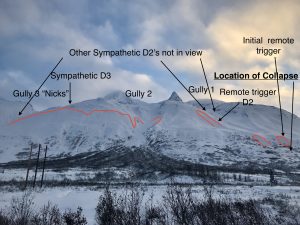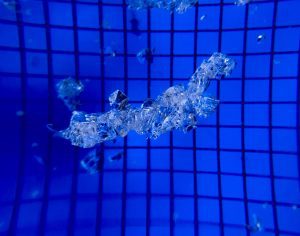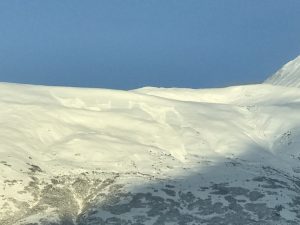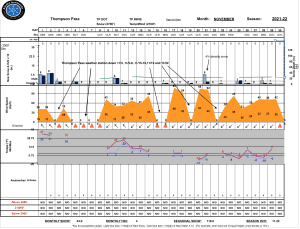Valdez
Above 4,000ftConsiderable
2,000 to 4,000ftConsiderable
Below 2,000ftConsiderable
Degrees of Avalanche Danger
Avalanche Problems
Problem 1
Arctic air and strong to very strong northeast winds have set in. Winds slabs 3 feet deep were reported yesterday in wind channeled terrain that were sensitive to human triggers on wind loaded rollovers. As wind speeds continue to increase, areas further away from the top of Thompson Pass will begin to form new wind slabs on lee aspects. High elevation ridgelines that are experiencing winds of 60+ MPH will likely see snow blown into the air and sublimating (turning from solid to gas state) before landing on lee aspects. Slabs that do form off high elevation ridge lines will likely be located further down from ridges than you may expect.
Wind slab avalanches will have the potential to step down into deeper faceted layers in our snowpack, (see problem 1) and produce larger avalanches. Avoid recently wind loaded slopes in terrain steeper than 32°. The hazard for this avalanche problem will be increasing over the next 48 hours, especially in areas away from the top of Thompson Pass where new wind slabs are forming
Likelihood:
- Almost Certain
- Very Likely
- Likely
- Possible
- Unlikely
Size:
- Historic
- Very Large
- Large
- Small
Trend
- Increasing
- Steady
- Decreasing
Problem 2
There is a 2-3+ foot deep slab sitting on the November facets. These facets have continued to show propagation in ECT and PST stability tests as recently as 12/11. Very strong northeast winds are loading lee aspects, further stressing facets in these areas. It is possible that we will see some natural avalanche activity on southerly aspects in the next 48 hours.
On 12/8 a remote triggered/sympathetic avalanche event (see observation section) is a clear sign that our persistent slab avalanche problem is hanging on by its fingernails. This is especially true in wind sheltered areas. In locations were old wind slabs exist above the November facets, weak layers may be more stubborn to triggers, due to bridging. But the same weak layer exists and dangerous human triggered avalanches are possible in these locations as well.
The 24 hour rule will not apply for our current setup. A common question to this problem is “What will it take to heal the snowpack?”. To understand the answer to this question it is important to understand how this problem formed. Without getting too in depth, a faceted snowpack forms when the snowpack is shallow and temperatures are cold for an extended period of time. Unfortunately, snow can turn to facets (weak snow) much quicker than it can turn back into rounds (strong snow). There are a few things that need to occur for our snowpack to heal. The quickest fix would be a very large warm and wet Pacific storm that delivers significant amounts of dense snowfall to our region in a short period of time (> 3 inches of SWE in < 24 hours). The result would be a widespread natural avalanche cycle that would clean out the areas where the snowpack is the weakest. This is commonly referred to as a (Crush and Flush event). Another way for our snowpack to heal which is much slower and requires a lot of patience, would be for incremental storms to build the depth of our snowpack along with an increase in temperatures. This combination would promote sintering (creation of rounds or strong snow) in our snowpack, this is a very slow process. Unfortunately, neither one of these scenarios is in the short, or long term forecast. Our dangerous snowpack is here to stay for now…
The only successful mitigation practices for a persistent slab avalanche problem are patience, and a conservative approach in choosing terrain. Good protocols are very important as well during this type of avalanche problem ie: only exposing one person at a time to an avalanche prone slope, good communication and having an escape route should a slope fail.
Some important things to remember about a persistent weak layer problem is that tracks are not a sign of stability. A slope can fail after many tracks have been laid down. Remotely triggered avalanches are possible (triggering a slope above, below or adjacent to your position). Pay attention to the terrain above you and what the consequences would be if that slope were to fail.
Photo of Remote triggered/sympathetic avalanches on 12/8
1cm+ chained facet found buried 40 cms (16″) on Catchers Mitt 3500′ SE aspect.


Likelihood:
- Almost Certain
- Very Likely
- Likely
- Possible
- Unlikely
Size:
- Historic
- Very Large
- Large
- Small
Trend
- Increasing
- Steady
- Decreasing
Avalanche Activity
12/8- Large remote trigger/ sympathetic avalanche event occurred 12/8 with avalanches extending from Gully 1 to Nicks. Avalanches were soft slabs that ranged in size from D1-D3. Over 10 separate avalanches were counted with crown depths averaging 2-3′. One avalanche had a crown length of half a mile while another was triggered over a mile away from the point of collapse. See observation section for full report and more photos.

12/7- Only a few natural avalanches were noted during the last storm. It is likely there were more during the storm, but crowns may have been filled in by subsequent wind and snow.
D2’s on Town mountain was observed ~3000′
A couple of D2’s were noted in N. Oddessey gully and Big Oddessey.
D2 on 40.5 mile peak ~5500′.
12/2-12/3- Several natural D2 avalanches were noted on south aspects of Three pigs, Hippie Ridge and Averys. These windslab avalanches originated between 4000-5500 feet elevation.

Weather
NWS Watches and Warnings
Northeast Prince William Sound-
Including the cities of Valdez and Thompson Pass
459 AM AKST Sun Dec 12 2021
...HIGH WIND WARNING NOW IN EFFECT UNTIL 6 PM AKST THIS EVENING
THROUGH THOMPSON PASS...
* WHAT...Northeast winds 30 to 50 mph with gusts up to 75 mph
expected.
* WHERE...Thompson Pass.
* WHEN...Until 6 PM AKST this evening.
Point forecast for Thompson Pass
Detailed forecast for Thompson Pass (mid elevation 2000-4000′)
DATE SUNDAY 12/12 MONDAY 12/13
TIME (LT) 06 12 18 00 06 12 18 00 06
CLOUD COVER SC FW CL CL CL OV OV OV OV
CLOUD COVER (%) 30 10 5 5 5 70 75 90 90
TEMPERATURE -4 -10 -14 -15 -14 -10 1 7 6
MAX/MIN TEMP -2 -15 -5 -8
WIND DIR NE NE NE NE NE NE E E NE
WIND (MPH) 34 35 33 26 20 10 9 8 9
WIND GUST (MPH) 77 75 70 63 56
PRECIP PROB (%) 0 0 0 5 10 40 60 60 50
PRECIP TYPE S S S S
12 HOUR QPF 0.00 0.00 0.03 0.07
12 HOUR SNOW 0.0 0.0 0.0 1.0
SNOW LEVEL (KFT)0.0 0.0 0.0 0.0 0.0 0.0 0.0 0.0 0.0
Snow and Temperature Measurements
| Date: 12/12 | 24 hr snow | HN24W* | High Temp | Low Temp | Weekly SWE (Monday- Sunday) | December Snowfall | Season Snowfall | HS (Snowpack depth) |
| Valdez | 0 | 0 | 26 | 14 | 1.58 | 46 | 70 | 24 |
| Thompson Pass | 0 | 0 | 10 | 0 | N/O | ~30 | 149 | N/O |
| 46 Mile | 0 | 0 | 19 | 4 | .9 | 22 | 22** | 24
|
All snowfall measurements are expressed in inches and temperature in Fahrenheit. 24 hour sample period is from 6am-6am.
* 24 hour snow water equivalent/ SWE.
** Season total snowfall measurements for 46 mile began December 1st.
Season history graphs for Thompson Pass

Click on links below to see a clear and expanded view of above Season history graphs
Additional Information
Winter weather began early this season, with valley locations receiving their first snowfall on the last day of Summer (September 21st). Following this storm, above average temperatures and wet weather occurred from late September through early November. During this time period Thompson Pass received 96 inches of snowfall by November 7th and Valdez recorded 7.73″ of rain.
After the 7th of November our region experienced a sharp weather pattern change. Temperatures dropped below seasonal norms and snowfall became infrequent. Between the time frame of November 7th- November 28th Thompson Pass only reported 19″ of snow with 1.1″ of Snow water equivalent (SWE). Temperatures remained below 0° F for most of the period. This cold/dry weather caused significant faceting of the snowpack, with poor structure the result.
Moderate snowfall returned to our area the last day of November and deposited 6-12 inches of new snow. The amount varied depending upon the locations’ proximity to the coast. As the storm exited on the 2nd of December it was quickly replaced by moderate to strong northeast winds.
On 12/5-12/6 Valdez received 2 feet of new snow with Thompson Pass reporting 16″. Blaring red flags like collapsing, shooting cracks and propagation in stability tests were immediately present. On 12/8 a significant remote/ sympathetic avalanche event occurred from Gully 1 through Nick’s Happy Valley. Incremental loading has resulted in a dangerous persistent avalanche problem at the present.
Announcements
Click the + Full Forecast button below for a list of current avalanche problems, travel advice, weather resources and more.
Help to improve your local avalanche center and contribute an observation to the website. You can also contact me directly at [email protected] (907)255-7690.

